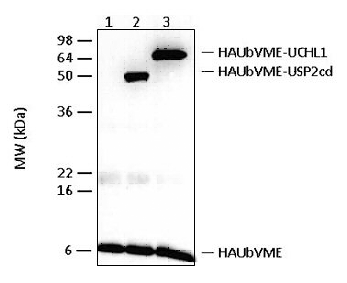Product Details
| Alternative Name: | HA-Ub-VME |
| |
| MW: | ~10’257Da |
| |
| Source: | Synthetic. |
| |
| UniProt ID: | P0CG47 (UBB), P0CG48 (UBC), P62979 (RPS27A), P62987 (UBA52) |
| |
| Formulation: | Lyophilized. |
| |
| Purity: | ≥95% (HPLC) |
| |
| Application Notes: | Suggested uses:
-
Active site-directed probes for detection of DUBs.
-
Isolation and identification of DUBs.
-
Identification of DUBs within biological samples.
|
| |
| Reconstitution: | Reconstitute with aqueous buffer up to 5mg/ml (~500μM). |
| |
| Shipping: | Dry Ice |
| |
| Short Term Storage: | -80°C |
| |
| Long Term Storage: | -80°C |
| |
| Use/Stability: | Stable for at least 6 months after receipt when stored at -80°C. |
| |
| Handling: | After reconstitution, prepare aliquots, store at -80°C and use within 1 month. Avoid freeze/thaw cycles. After opening, prepare aliquots and store at -80°C. |
| |
| Scientific Background: | The ubiquitin cascade in its many forms includes a large family of cysteine proteases known as deubiquitinylating enzymes (DUBs). Many members are assigned to this enzyme class by sequence similarity but with little evidence for specific biological activity.
HA-tagged ubiquitin molecules derivatised by chemical ligation at the C-terminus with thiol-reactive functional groups can be used as potent, irreversible inhibitors of DUBs through their covalent modification of the active site and, consequently, can act as specific probes for enzymes with DUB activity. Such probes have been utilized for the identification of DUBs and associated components from cell lysates by proteomic methods, as well as rapid demonstration of enzymatic activity for gene products whose functions were inferred from primary structure.
The nature of the electrophilic group used as the C-terminal derivative, for example vinyl sulfone (-VS), vinyl methylester (-VME), 2-bromoethyl (-Br) or 2-chloroethyl (-Cl), may determine the subset of DUB enzymes detected. The HA peptide sequence (YPYDVPDYA), derived from the influenza hemagglutinin protein, facilitates sensitive identification or purification of HA-Ub-VME modified DUBs through recognition by HA-reactive antibodies in free or agarose-immobilised. |
| |
| Regulatory Status: | RUO - Research Use Only |
| |

Figure: DUB active site probe assay: Western blot showing reactions containing HA-Ub-VME only (lane 1), HA-Ub-VME + GST-UCHL1 (lane 2, Prod. No.
BML-UW9305), and HA-Ub-VME + USP2cd (lane 3, Prod. No.
BML-UW9850). HA-Ub-VME modified proteins detected using HA-reactive polyclonal antibody (Sigma – H6908) at 1:1000 dilution.Typical assay set-up: HA-Ub-VME probe concentration: 0.5-5.0μM. Purified enzyme concentration: 0.1-1.0µM; Buffer: 50mM TRIS, pH7.5, 150mM NaCl, 1mM DTT. Incubate at 37ºC for 30 minutes. Modification of DUB enzymes by site-directed HA-Ub-VME probes detected by Western blotting with either HA-reactive antibody (general reactivity) or an antibody specific to particular DUB of interest.
Note: When probing complex solutions such as cell lysates the optimal amount of total sample protein required will depend on the specific lysate to be analyzed and must therefore be determined for the individual lysate of interest."
Please mouse over
Product Literature References
Mutation of aspartic acid 199 in USP1 disrupts its deubiquitinating activity and impairs DNA repair: S.W. Jang & J.M. Kim; FEBS Lett.
595, 1997 (2021),
Abstract;
General Literature References
Structural basis and specificity of human otubain 1-mediated deubiquitination: M.J. Edelmann, et al.; Biochem. J.
418, 379 (2009),
Abstract;
Derivitization of the C-terminus of ubiquitin and ubiquitin-like proteins using intein chemistry: methods and uses: K.D. Wilkinson, et al.; Methods Enzymol.
399, 37 (2005),
Abstract;
Activity-based ubiquitin-specific protease (USP) profiling of virus-infected and malignant human cells: H. Ovaa, et al.; PNAS
101, 2253 (2004),
Abstract;
Full Text
Chemistry-based functional proteomics reveals novel members of the deubiquitinating enzyme family: A. Borodovsky, et al.; Chem. Biol.
9, 1149 (2002),
Abstract;
A novel active site-directed probe specific for deubiquitylating enzymes reveals proteasome association of USP14: A. Borodovsky, et al.; EMBO J.
20, 5187 (2001),
Abstract;
Full Text













